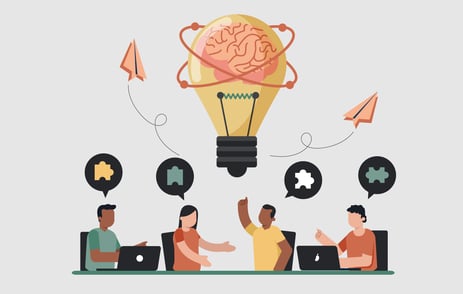Artificial Intelligence (AI) is promising to revolutionize the way organizations operate and innovate. Associations, too, are beginning to explore the potential of AI to enhance their services, streamline operations, and drive growth. However, navigating the world of AI adoption requires more than just implementing new technologies. It demands effective change management strategies that address the unique challenges faced by associations.
In this blog, we delve into the topic of change management in the context of AI adoption in associations. We explore three different levels of change: top-down, bottom-up, and navigating governance challenges. Each level presents its own set of opportunities and obstacles that associations must navigate to successfully integrate AI into their operations.
The Top-Down Approach to Change
When it comes to implementing change, a top-down approach is often the starting point. Senior management or CEOs play a crucial role in setting a clear, compelling, and decisive vision for the organization. This vision should include specific goals and timeframes to provide a sense of direction and urgency.
Establish Clear Goals and Timeframes
Setting clear goals and timeframes is essential for driving innovation and overcoming resistance to change. No matter the scale of the change, having specific, measurable objectives is vital. For instance, if your association aims to adopt AI tools, consider setting a goal that requires all team members to use at least one AI tool in their daily work within the next 90 days. This aggressive yet achievable goal encourages adaptation to new technology while fostering a sense of collective responsibility.
Create Meaningful Use of AI Tools
Merely adopting AI tools is not enough; they must be used meaningfully in daily work. Encourage team members to fully integrate these tools into their tasks, going beyond surface-level experimentation. For example, team members who write articles for your association's blog or magazine could employ AI tools like ChatGPT as brainstorming partners, first-draft copywriters, or editing assistants. Embracing constraints, such as time-bound goals, can mobilize your team's creative and adaptive abilities.
The Importance of Small Wins
Celebrating small wins is vital in the change management process. Achieving incremental goals, such as successful AI tool adoption, paves the way for more significant change initiatives. By acknowledging and celebrating these victories, you boost morale, create momentum, and encourage further advancements in AI technologies throughout your organization.
Realize the Power of Moonshots
John F. Kennedy's moonshot goal of landing a man on the moon within a decade stands as an emblematic example of a Big Hairy Audacious Goal (BHAG). This bold and seemingly impossible goal inspired innovation and progress. Kennedy's goal had a compelling vision, clarity in measurability, a time constraint, and the audacity to embrace the impossible. Associations can learn from moonshot goals to drive innovation and achieve extraordinary outcomes.
Understand the Importance of Bold Leadership and Setting Non-Negotiable Goals
Non-negotiable goals are essential in driving change, forming a clear and unwavering direction for the organization. Leaders must adopt a bold vision, be willing to take risks, and provide unambiguous expectations for their teams. Overcoming organizational inertia and balancing non-negotiable visions with flexibility are also critical aspects of change management. By empowering teams with a clear vision and leading by example, leaders inspire trust, loyalty, and commitment to organizational transformation.
Change from the Bottom Up
Driving change within an organization is not exclusive to those in positions of formal authority. Early career professionals and middle managers can also make a significant impact from the bottom up. Embracing consumer-grade AI tools, demonstrating their impact on work, sharing successes generously, and taking small risks without seeking permission are ways to influence change. By leveraging their influence as middle managers and even as individual contributors, fostering a culture of continuous improvement, showcasing granular successes, and seizing opportunities for leadership and growth, early- to mid-career contributors can inspire others and drive change.
Navigating Governance Challenges to Change
Governance challenges, such as restrictive bylaws or a risk-averse board, can impede change. Overcoming these challenges requires:
- Proactive communication about the importance of innovation: Gain a general understanding of how AI works, its implications for your industry, and the ways it can be used in your organization. This will help you make informed decisions and address any concerns or misconceptions.
- Building a coalition of support: Engage key stakeholders, including board members, staff, and members, in the decision-making process. Clearly communicate the potential benefits of AI adoption and address any concerns or questions they may have. This will help build support and ensure a smooth transition.
- Starting with low-risk experiments: Begin by implementing AI in a smaller part of your association's strategy to make meaningful differences over time. This approach allows you to learn and adjust as you go, minimizing risks and maximizing the benefits of AI.
- Fostering a culture of learning and adaptability: Educate yourself and empower your team to do the same. Prioritizing a culture of change means accepting
- Leveraging success stories: Did the adoption of one AI tool, ChatGPT for example, allow your marketing team to double event registrations? Celebrate that. By focusing on what works best and scaling successful experiments, associations can drive meaningful change and make progress towards their long-term goals.
- Advocating for necessary bylaw revisions: By their nature, associations have robust governance structures that can impede agility. But they aren't immutable.
- Involving members in the change process: Your members are stakeholders, too, and should be treated as such. Be transparent about your process and check in with them to make sure you are meeting their needs.
By addressing these governance challenges head-on, associations can pave the way for successful AI adoption.
AI is a Powerful Tool, but Only for Associations That Embrace It.
As associations navigate the complex landscape of AI adoption, effective change management strategies become paramount. By implementing a top-down approach, embracing bottom-up change, and navigating governance challenges, associations can harness the power of AI to drive innovation, enhance member services, and achieve extraordinary outcomes. To further explore the potential of AI for associations and unlock the power of change, we invite you to download our book, Ascend: Unlocking the Power of AI for Associations. This comprehensive guide provides insights, strategies, and practical tips for associations on their AI journey. Embrace the transformative power of AI and propel your association into the future. Download Ascend today!

Tags:
Artificial Intelligence
July 27, 2023


